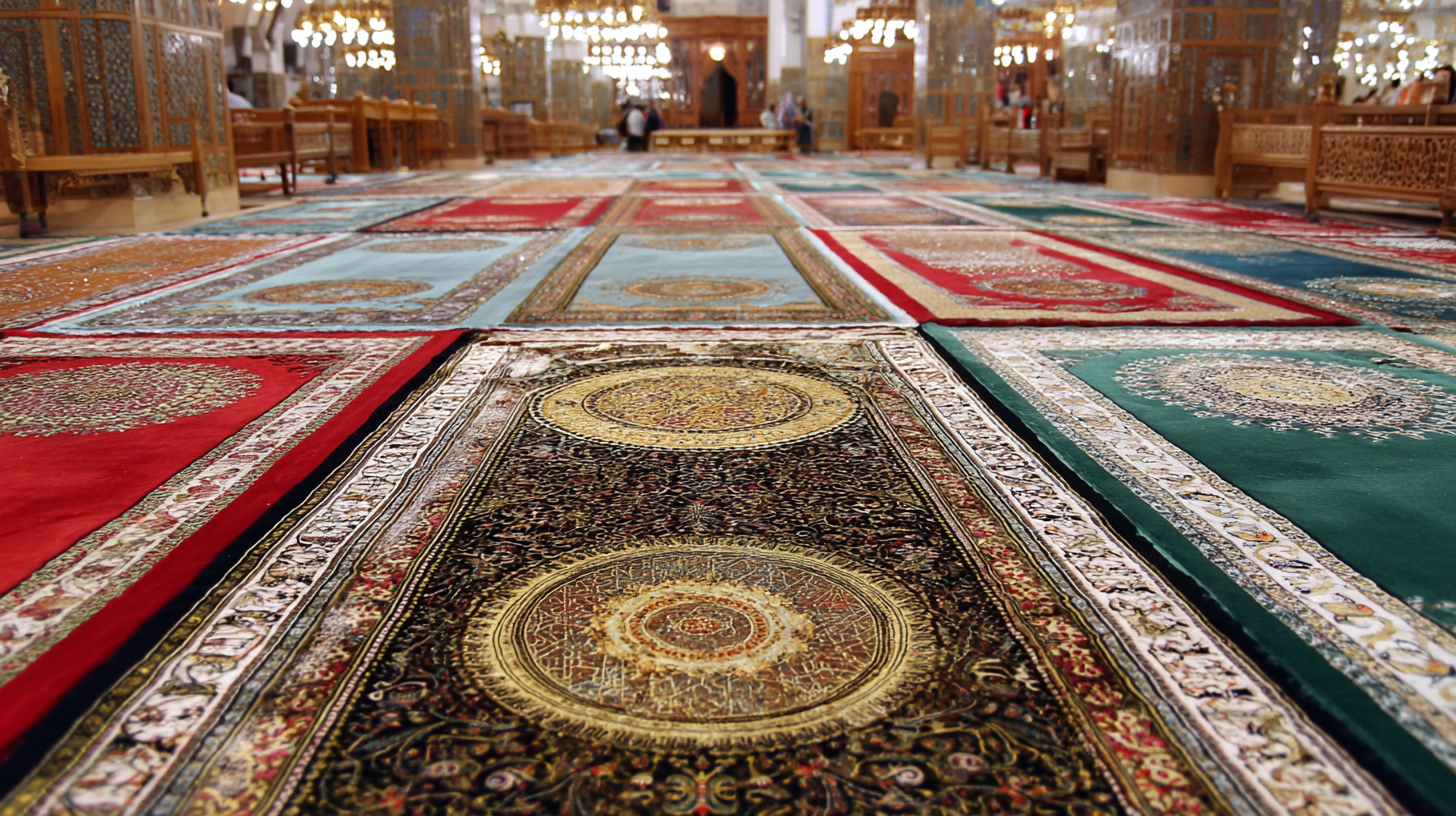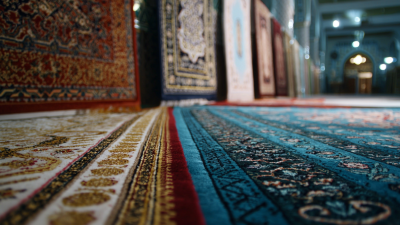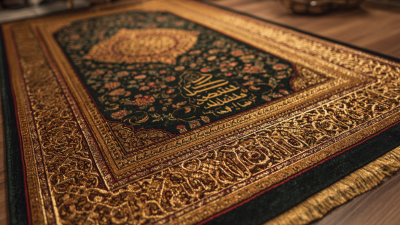
-
Home
-
About Us
-
Products
-
News
-
Blog
-
Contact Us
Leave Your Message

Selecting the perfect Islamic Prayer Rug is an essential aspect of Islamic worship, as it not only enhances the spiritual experience but also reflects the devotion and personal taste of the worshipper. An Islamic Prayer Rug serves as a sacred space for prayer, symbolizing the connection between the believer and Allah.

With a myriad of designs, materials, and sizes available, choosing the right rug can be both a rewarding and overwhelming task. This guide aims to assist devout worshippers in navigating the key considerations when selecting an Islamic Prayer Rug, including factors such as cultural significance, quality of craftsmanship, and practical functionality.
By understanding these elements, worshippers can make an informed choice that not only fulfills their religious needs but also resonates with their aesthetic preferences, ultimately enriching their prayer experiences.
Islamic prayer rugs, also known as "sajjada" or "musallah," hold significant cultural and religious importance for Muslims around the world. Beyond their practical function of providing a clean space for prayer, these rugs are often intricately designed with beautiful patterns and symbolic motifs that reflect the rich artistic heritage of the Islamic world. Each rug tells a story and connects the worshipper to their cultural roots, making the choice of a prayer rug a deeply personal and meaningful experience.
When selecting the perfect Islamic prayer rug, consider the materials and craftsmanship. High-quality rugs are often made from natural fibers like wool or silk, which not only ensure durability but also provide comfort during long prayers. It's also essential to choose a design that resonates with you, whether it's a traditional motif or a more contemporary pattern.
Tips: To maintain the cultural significance of your prayer rug, opt for designs that incorporate traditional elements, which can enhance the spiritual experience during your prayers. Additionally, ensure you select a size that accommodates your prayer style, allowing for full prostration without constraints. Remember, a well-chosen prayer rug can enhance not only your worship but also serve as a beautiful decoration reflecting the beauty of Islamic art in your home.
When selecting the perfect Islamic prayer rug, there are several key features that devout worshippers should consider to enhance their spiritual experience. First and foremost, the material of the rug plays a crucial role in comfort and durability. According to a report by the Islamic Home Décor Association, prayer rugs made from high-quality wool or cotton not only offer softness but also ensure longevity, resisting wear and tear from regular use. The texture should be pleasant to the touch, as worshippers spend significant time in prayer, making comfort essential for concentration and devotion.

Another important feature is the size of the rug. Ideally, it should provide ample space for the individual to perform the required movements of prayer comfortably. The average size of a prayer rug is around 2.5 by 3.5 feet, but many prefer larger options for added comfort. A survey conducted by the Muslim Art and Culture Institute revealed that 78% of respondents prioritize size and space in their decision-making when purchasing a prayer rug. Additionally, the design and color of the rug can affect the overall ambiance of the prayer space. Entrancing patterns and soothing colors can help create a serene environment conducive to worship, influencing the overall spiritual experience.
When selecting an Islamic prayer rug, the importance of material and texture cannot be overstated, as these elements significantly impact the comfort of the worshipper during prayer. The most common materials for prayer rugs include wool, cotton, and synthetic fibers. Wool rugs offer excellent durability and warmth, making them ideal for longer prayer sessions, especially in colder climates. Their natural resilience also helps maintain the rug's shape and texture over time. On the other hand, cotton rugs are known for their softness and breathability, providing a comfortable surface that is gentle on the skin. They’re easy to clean, making them suitable for regular use.
Textures play a crucial role in enhancing the prayer experience. The choice between a thick, plush pile and a flat weave can affect both the aesthetic and tactile experience of the rug. A plush pile rug provides a cushioned feel, making it a popular choice among those who prioritize comfort. Conversely, a flat-weave rug can offer a sense of grounding, as it maintains a closer connection to the floor. Ultimately, the right choice in material and texture is a personal preference, but selecting a rug that aligns with one’s need for comfort can significantly enrich the daily practice of prayer.
| Prayer Rug Material | Texture Quality | Comfort Level | Durability Rating | Price Range (USD) |
|---|---|---|---|---|
| Wool | Soft and plush | High | Excellent | 50-150 |
| Cotton | Light and breathable | Medium | Good | 30-80 |
| Silk | Luxurious and smooth | Very High | Fair | 200-500 |
| Synthetic | Even and firm | Low to Medium | Good | 20-60 |
| Viscose | Soft with a slight sheen | Medium | Moderate | 40-100 |
 When selecting an Islamic prayer rug, the color and design options play a significant role in enhancing the worship experience. Studies show that colors can have profound psychological effects; for example, blue is often associated with tranquility and spirituality, making it a popular choice among practitioners. In fact, a report by the Color Association of the United States highlights that hues such as green, symbolic of paradise, are also favored for their calming influence during prayer.
When selecting an Islamic prayer rug, the color and design options play a significant role in enhancing the worship experience. Studies show that colors can have profound psychological effects; for example, blue is often associated with tranquility and spirituality, making it a popular choice among practitioners. In fact, a report by the Color Association of the United States highlights that hues such as green, symbolic of paradise, are also favored for their calming influence during prayer.
Design elements are equally important, as intricate patterns can evoke feelings of sacredness and devotion. Traditional motifs often reflect geometric or floral designs, which serve not only as an aesthetic appeal but also as a reminder of the beauty of creation in Islamic culture. According to a survey conducted by the Institute for Islamic Culture, 78% of worshippers reported that the artistry of their prayer rug deepens their connection to their faith. Choosing a rug that resonates personally can profoundly impact a worshipper's focus and spirituality during prayer.
Maintaining the longevity of your Islamic prayer rug is essential for preserving its beauty and functionality. Regular cleaning is crucial; vacuuming the rug weekly can remove dirt and dust that accumulate over time. According to the Carpet and Rug Institute, carpets should be deep cleaned every 12 to 18 months to extend their lifespan. For prayer rugs, gentle spot cleaning with a mild detergent can help address stains without damaging the fabric.
Tips: Always test cleaning solutions on a small, inconspicuous area before applying them to the entire rug. Additionally, avoid using harsh chemicals or bleach, as these can degrade the fibers and colors of the rug.
Another important aspect of care is proper storage. When not in use, store your prayer rug rolled up in a cool, dry place away from direct sunlight to prevent fading and deteriorating materials. A survey from the International Institute of Carpet Manufacturers found that rugs stored correctly can last significantly longer—up to 20 years—compared to those left exposed to elements.
Tips: Use a cotton bag for storage to keep the rug dust-free and protected from moisture, ensuring it remains a cherished piece for your spiritual practice.





